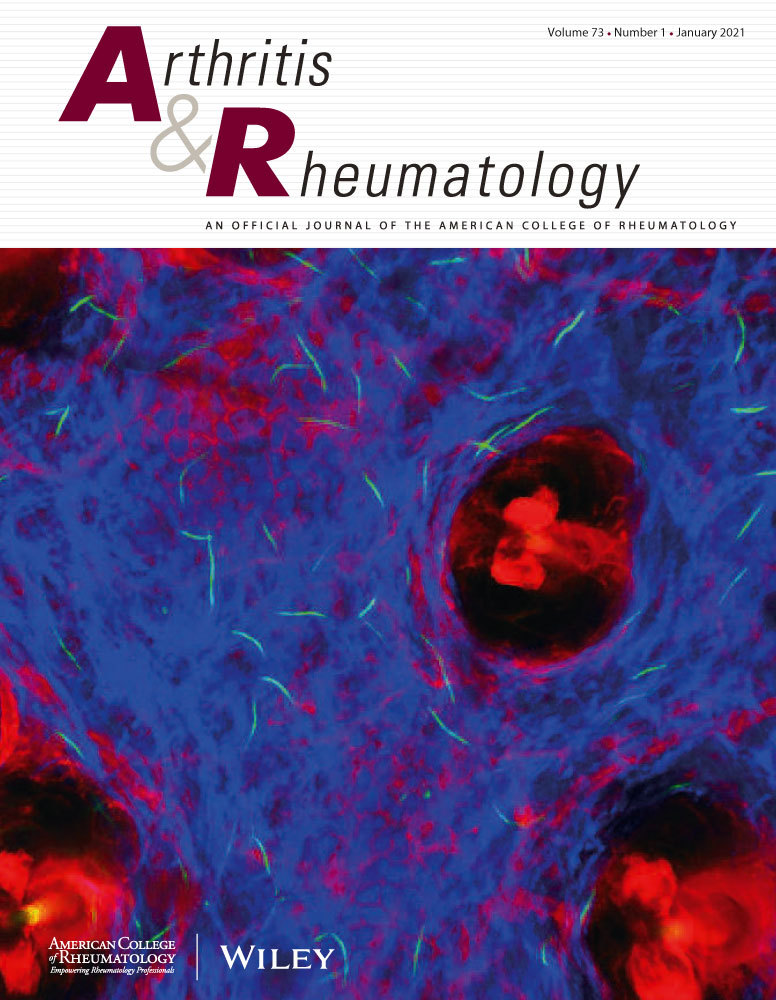羟氯喹在类风湿关节炎高危人群中的2期临床试验
IF 10.9
1区 医学
Q1 RHEUMATOLOGY
引用次数: 0
摘要
背景:血清抗环瓜氨酸肽(anti - CCP)抗体升高的个体未来患类风湿关节炎(RA)的风险增加。没有药物干预措施被批准用于预防此类“高危”个体的类风湿性关节炎。然而,羟氯喹(HCQ)的使用没有支持临床试验证据。方法在这项2期随机试验中,抗CCP≥2倍正常上限(ULN)的RA风险个体被分配接受HCQ或安慰剂治疗12个月,并进行长达24个月的药物后随访。主要结局是临床RA的发展,如方案中定义的,在36个月时。次要结局包括安全性、炎症性关节炎(IA)的发展和参与者报告的关节症状。结果144名随机参与者中,71人被分配到HCQ组,73人被分配到安慰剂组。在改良的意向治疗人群中,HCQ组69名参与者中有21名(30.4%)出现临床RA,安慰剂组73名参与者中有24名(32.9%)出现临床RA。36个月时,HCQ组临床RA的风险为0.336,安慰剂组为0.394(差异为0.058;95%可信区间为0.336至0.220;P=0.52)。IA的结果相似。关节症状的发生和严重程度在两组间无差异。两组不良事件发生率相似。结论:在这项涉及抗CCP水平≥2倍ULN的个体的试验中,12个月的HCQ并没有阻止36个月时临床RA的发展。(由国家过敏和传染病研究所资助;ClinicalTrials.gov号码,NCT02603146.本文章由计算机程序翻译,如有差异,请以英文原文为准。
A phase 2 trial of hydroxychloroquine in individuals at risk for rheumatoid arthritis
BackgroundIndividuals with serum elevations of anti‐cyclic citrullinated peptide (anti‐CCP) antibodies are at increased risk for future rheumatoid arthritis (RA). No pharmacologic interventions have been approved for the prevention of RA in such ‘at‐risk’ individuals. However, hydroxychloroquine (HCQ) is used without supporting clinical trial evidence.MethodsIn this phase 2 randomized trial, individuals at‐risk for RA with anti‐CCP ≥2 times the upper limit of normal (ULN) were assigned to receive HCQ or placebo for 12 months, with up to 24 months of post‐drug follow‐up. The primary outcome was the development of clinical RA, as defined in the protocol, at 36 months. Secondary outcomes included safety, development of inflammatory arthritis (IA), and participant‐reported joint symptoms.ResultsOf 144 randomized participants, 71 were assigned to HCQ and 73 to placebo. In the modified intent‐to‐treat population, clinical RA occurred in 21 of 69 (30.4%) participants in the HCQ group and 24 of 73 (32.9%) in the placebo group. The risk of clinical RA at 36 months was 0.336 with HCQ and 0.394 with placebo (difference ‐0.058; 95% confidence interval ‐0.336 to 0.220; P=0.52). Results for IA were similar. The occurrence and severity of joint symptoms were not observed to differ between groups. Adverse event incidence was similar between groups.ConclusionsIn this trial involving individuals with anti‐CCP levels ≥2 times the ULN, 12 months of HCQ did not prevent the development of clinical RA at 36 months. (Funded by the National Institute of Allergy and Infectious Diseases; ClinicalTrials.gov number, NCT02603146.)image
求助全文
通过发布文献求助,成功后即可免费获取论文全文。
去求助
来源期刊

Arthritis & Rheumatology
RHEUMATOLOGY-
CiteScore
20.90
自引率
3.00%
发文量
371
期刊介绍:
Arthritis & Rheumatology is the official journal of the American College of Rheumatology and focuses on the natural history, pathophysiology, treatment, and outcome of rheumatic diseases. It is a peer-reviewed publication that aims to provide the highest quality basic and clinical research in this field. The journal covers a wide range of investigative areas and also includes review articles, editorials, and educational material for researchers and clinicians. Being recognized as a leading research journal in rheumatology, Arthritis & Rheumatology serves the global community of rheumatology investigators and clinicians.
 求助内容:
求助内容: 应助结果提醒方式:
应助结果提醒方式:


